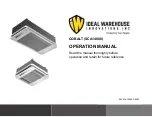
Page 9
alloys and flux.
BRAZE LINE SET
Cloths must remain water-saturated throughout the brazing and
cool-down process.
6
After all connections have been brazed, disconnect manifold gauge set from service ports. Apply additional water-saturated cloths to both
services valves to cool piping. Once piping is cool, remove all water-saturated cloths.
PREPARATION FOR NEXT STEP
7
WRAP SERVICE VALVES
To help protect service valve seals during brazing, wrap water-saturated cloths around service valve bodies and copper tube stubs. Use
additional water-saturated cloths under the valve body to protect the base paint.
4
FLOW NITROGEN
Flow regulated nitrogen (at 1 to 2 psig) through the refrigeration
gauge set into the valve stem port connection on the liquid service
valve and out of the suction / vapor valve stem port. See steps
3A, 3B
and
3C
on previous page and below for manifold gauge setup.
5
SUCTION / VAPOR LINE
WHEN BRAZING LINE SET TO
SERVICE VALVES, POINT FLAME
AWAY FROM SERVICE VALVE.
LIQUID LINE
WATER-SATURATED
CLOTHS
WATER-SATURATED CLOTHS
6A
6B
SUCTION / VAPOR SERVICE
PORT MUST BE OPEN AND
MOVED TO ALLOW EXIT POINT
FOR NITROGEN FLOW
IMPORTANT !
Allow braze joint to cool. Apply additional
water-saturated cloths to help cool brazed
joints. Do not remove water-saturated cloths
until piping has cooled. Temperatures above
250ºF will damage valve seals.
WARNING
FIRE, PERSONAL INJURY, OR PROPERTY DAMAGE
may result if you do not wrap a water-saturated cloth around
both liquid and suction line service valve bodies and copper
tube stub while brazing the line set! The braze, when
complete, must be quenched with water to absorb any
residual heat.
Do not open service valves until refrigerant lines and
indoor coil have been leak-tested and evacuated. Refer
to Installation and Service Procedures manual found on
DAVENET.
1. Braze liquid line to liquid line service valve.
2. Braze suction / vapor line to suction / vapor service
valve.
IMPORTANT !
Use silver alloy brazing rods with 5%
minimum silver alloy for copper-to-copper
brazing and 45% alloy for copper-to-brass
or copper-to-steel brazing.
FIGURE 4









































